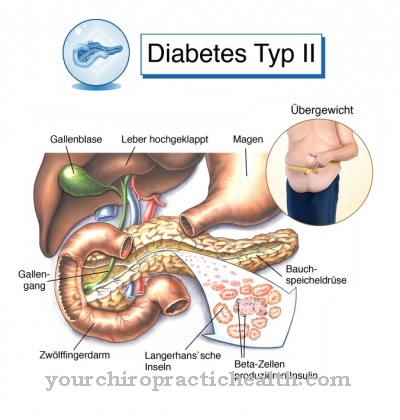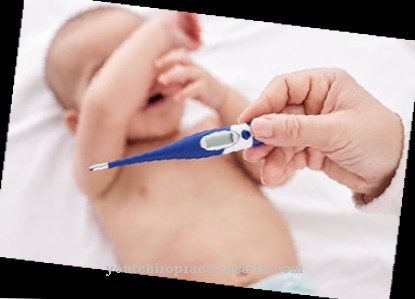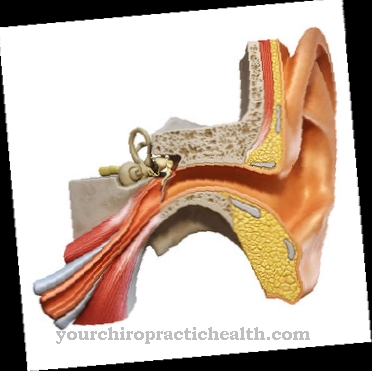Under the Alice in Wonderland Syndrome a complex of neurological symptoms is understood that is associated with a disturbed perception of the environment and / or one's own person. Alice in Wonderland syndrome most commonly affects migraine and epilepsy patients and young children.
What is Alice in Wonderland Syndrome?

Alice in Wonderland Syndrome is a distorted perception of the environment and / or of oneself, which in most cases can be attributed to various underlying diseases such as migraines, epilepsy, infections with certain viruses (Epstein-Barr virus) or substance abuse can.
An Alice in Wonderland syndrome, which is not regarded as an independent disease, usually manifests itself in a metamorphopsia, through which objects are enlarged (macropsia) or reduced (micropsia), further away (teleopsia, porropsia) or closer (pelopsia ), distorted, deformed, spatially displaced (mirror-inverted, upside down) or color-modified.
In addition, an Alice-in-Wonderland syndrome can express itself through disturbances of the ego experience (depersonalization, splitting of soul and body), a disturbed sense of time, ashes (disorders of the body scheme) as well as feelings of floating and disturbances of the sense of hearing and tact. Anxiety and panic states, pronounced fatigue and headaches, dizziness, vomiting and nausea can represent further symptoms of Alice in Wonderland syndrome.
causes
The causes of Alice in Wonderland Syndrome have not yet been fully clarified. Based on the characteristic symptoms, organic and / or functional malformations of the temporal lobe (lobus temporalis), the primary auditory cortex, the sensory language center (Wernicke center), the visual working memory and neocortical associative areas (processing of complex non-spatial areas) are assumed to be the trigger of the syndrome auditory and visual stimuli).
Lesions in this area, especially the associative temporal cortex, can lead to various auditory and visual deficits (agnosias) such as object diagnosis, prosopagnosia (facial blindness), amusia (impaired perception of sounds) or aphasia (speech disorders).
In addition, epilepsy is associated with disorders of the temporal lobe (temporal lobe epilepsy). In addition to epileptic seizures, Alice in Wonderland syndrome occurs in connection with migraines, viral infections (Epstein-Barr virus), drug abuse (drug abuse) and in the phases between waking and sleeping (hypnagogic and hypnopompic states).
You can find your medication here
➔ Medicines to calm down and strengthen nervesSymptoms, ailments & signs
An Alice in Wonderland syndrome is initially expressed by acute or gradual changes in the perception of one's own environment. In addition, there are usually accompanying symptoms such as tiredness and exhaustion or headaches. The affected people often feel confused or suffer from indefinable fear.
Hallucinations and sensitivity to light and sound can also occur. Some people affected have a changed sense of time or an unusual sense of touch for a short or long period of time. A typical feeling is that everything is perceived as being reduced or enlarged. This micropsia or macropsia often leads to dizziness and gait disorders - those affected can no longer find their way around in their familiar surroundings.
If it is severe, neurological failures can occur. The child then perceives “fantastic pictures” or suffers epileptic seizures. The symptoms usually appear in childhood, but can continue into adulthood and may persist throughout life.
Unusual sensations and physical or mental complaints are particularly common during the sleep and wake-up phases. The stress that this creates can lead to accompanying symptoms such as abdominal pain, migraines, insomnia, depression and personality changes.
Diagnosis & course
Alice in Wonderland syndrome is diagnosed on the basis of the symptoms described in the anamnesis of the person affected, in particular the perceptual disorders characteristic of the syndrome.
An Alice in Wonderland syndrome can be assumed here if possible other physiological impairments in addition to the typical underlying diseases for the manifestation of the syndrome can be ruled out. The specific disease causing the syndrome (migraine, epilepsy or viral infection) should be determined in a differential diagnosis.
While diagnostic imaging procedures such as computed tomography (CT), magnetic resonance imaging (MRT), EEG or Doppler sonography can provide information about an underlying epilepsy or migraine, viral infectious diseases (Epstein-Barr virus) are detected by blood analyzes.
Alice in Wonderland Syndrome is often diagnosed in childhood. Although the syndrome resolves on its own in many cases during puberty, Alice in Wonderland syndrome affects some of those affected for life, especially when they fall asleep and wake up.
Complications
Alice in Wonderland Syndrome is common in children who may have social problems because of the symptoms. Other children may fear the syndrome and withdraw from the affected child. They may also react with mockery and malice, which can extend to bullying.
The stress that this creates can result in additional complications for the affected child - for example a deterioration in the general state of health, abdominal pain, headache or psychological disorders such as anxiety disorders, depression and sleep disorders. Adults can also suffer from the social and psychological complications of the syndrome.
The orientation disorders that occur in the context of Alice in Wonderland syndrome can lead to getting lost or lost in both children and adults. In some cases, adolescents and adults can be accused of alcohol or drug use. The disorientation can lead to restrictions in everyday life.
For example, if an acute episode occurs on the way to an important appointment, the person may be late or become so disoriented that they will not remember how they got to a place later. In particular, the chronic form of Alice in Wonderland Syndrome can result in far-reaching restrictions in lifestyle. Other complications can also occur and depend primarily on the underlying disease that is causing the syndrome.
When should you go to the doctor?
If Alice in Wonderland syndrome is suspected, a doctor must clarify the cause and treat it if necessary. Medical advice is particularly needed when there are frequent misperceptions that cannot be traced back to any specific cause and that restrict the person concerned in everyday life.
If these changes in perception and hallucinations have a negative impact on general well-being, a doctor or psychologist must be consulted with the child concerned. This is especially true if accidents or falls occur during an attack.
If an affected child describes “fantastic pictures” and / or perceives certain parts of the body to be larger or smaller, the syndrome should be clarified immediately. Most of the time, Alice in Wonderland Syndrome is based on a comparatively harmless underlying condition such as a migraine, which can be treated without any problems.
If the cause remains untreated, however, the Alice in Wonderland syndrome can develop into severe mental disorders. In addition, the seizures can lead to exclusion in everyday life. At the latest when parents notice changes in their child and the symptoms mentioned, they should speak to an appropriate specialist.
Doctors & therapists in your area
Treatment & Therapy
Since the Alice in Wonderland syndrome is a largely unexplored complex of neurological symptoms with a pathogenesis and etiology not fully understood, it cannot be treated causally.
Accordingly, the therapeutic measures in the case of Alice in Wonderland syndrome usually start with the diagnosed underlying diseases. In addition to the recommendation for strict rest during seizure phases, measures for the prophylaxis of migraine attacks are used. Antidepressants (amitriptyline), anticonvulsants, calcium antagonists or calcium channel blockers, analgesics and NSAID painkillers are used as medication.
In the case of very pronounced seizures, sedatives (tranquilizers) can also be used briefly to reduce the symptoms. In addition, a special migraine diet is recommended that includes avoiding chocolate, an overly meat-heavy diet, refined sugars, and the majority of denatured foods.
If the Alice in Wonderland syndrome is based on epilepsy, this is usually treated with medication using anticonvulsants or so-called "seizure blockers" (including carbamazepine, eslicarbazepine acetate, oxcarbazepine, valproic acid, benzodiazepines, zonisamide, phenobarbital). If those affected are resistant to drug therapy, surgical intervention (epilepsy surgery) can be considered, in which, if the area of the brain responsible for the seizures is known, it can be removed if necessary.
In addition, dietary measures accompanying therapy (ketogenic diet) are suggested. If the Alice in Wonderland Syndrome can be traced back to alcohol abuse, then alcohol abstinence is indicated. In addition, psychotherapeutic measures support those affected not only with regard to dealing with the underlying disease, but also with regard to Alice in Wonderland syndrome.
Outlook & forecast
In most cases, Alice in Wonderland Syndrome leads to a severely disturbed perception of the patient. Various stimuli and information cannot be processed or assigned correctly, which can lead to considerable restrictions and problems in the patient's everyday life. Most patients experience dizziness or fear. There is also an increased sensitivity to light and epileptic seizures are not uncommon. Migraine attacks also occur and can be accompanied by confusion.
Furthermore, the patients can suffer from hallucinations, which also reduces the quality of life. The symptoms often cause sleep disorders.Mental moods or depression can also complicate the patient's life. Often times, patients rely on the help of other people in their life.
Treatment of Alice in Wonderland Syndrome can take place with the help of therapies and medication. As a rule, it cannot be universally predicted whether this will lead to a positive course of the disease. The consumption of alcohol can also have a negative effect on the syndrome or even make it worse. Life expectancy can also be reduced.
You can find your medication here
➔ Medicines to calm down and strengthen nervesprevention
Since the exact pathogenesis and etiology of the Alice-in-Wonderland syndrome has not yet been conclusively clarified, it cannot be prevented directly. However, the therapeutic measures for the specific underlying disease should be followed consistently in order to prevent potential seizures and thus an Alice in Wonderland syndrome.
Aftercare
Alice in Wonderland Syndrome often requires extensive follow-up care. The reason for this finding lies in the complex mixture with other psychological abnormalities. While Alice in Wonderland Syndrome in children often goes by itself at puberty, this is usually not the case in adolescents and adults.
Both physical and mental disorders in combination with Alice in Wonderland syndrome can occur here. These can have serious consequences such as epilepsy, brain lesions, or severe viral infections. These are in need of treatment. They also need long-term medical monitoring.
The aftercare measures for Alice in Wonderland syndrome must be based on the symptoms and the secondary diseases that occur. Those affected often suffer severe cognitive disorders such as panic attacks or hallucinations. The perception of space or time can also change. This greatly unsettles those affected. The problem is that there are no effective therapy concepts for Alice in Wonderland Syndrome. Consequently, aftercare also suffers from a conceptual lack of effective therapy principles.
Therapy and aftercare measures are initially devoted to the underlying Illnesses or serious secondary illnesses. Otherwise, follow-up care can only be symptomatic. It is done with drugs. Follow-up care for children is particularly difficult. It is little consolation that the affected child often experiences the spontaneous disappearance of the stressful disorders during puberty.
You can do that yourself
To date, the exact pathogenesis and etiology of Alice-in-Wonderland syndrome has not been clearly established. Therefore, doctors are unable to give specific advice on how patients can effectively prevent the syndrome.
In a large number of cases, however, at least the responsible causes can be countered preventively. The focus is therefore on treating the underlying disease. In order to avoid potential seizures, the person affected should consistently pursue therapeutic measures for the individual underlying illness.
In terms of prevention, excessive consumption of alcohol or drugs should be avoided. A change in diet is also seen as extremely important. To prevent the syndrome from appearing, the prescribed medication should be taken in the specified cycle.
If the symptoms are severe and acute, the person affected should move to a familiar and familiar environment and, if possible, allow someone to calm them down. If there is no improvement or if the symptoms even worsen, a doctor can briefly administer a sedative to alleviate the attack or let it subside.





.jpg)



















.jpg)


